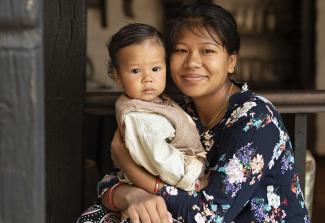Population trends
Demographic transition
 picture-alliance/imageBROKER
picture-alliance/imageBROKER
Death rates always fall before fertility rates do. Therefore, populations initially increase fast. Later, fertility rates begin to fall – provided that prosperity increases, education improves and people have more individual options in their lives. Population growth slows down accordingly, until it stops altogether. Because of the low fertility rate and a high life expectancy, the societies concerned become older and older.
The frontrunners of the demographic transition are the prosperous nations of the global North. They are now in the final phase of this transformation. Their current birth rates tend to be far below the so-called replacement level of 2.1 children per woman, at which a population size is stable in the long run without needing immigrants. In some countries, populations have actually begun to shrink.
In some developing countries and emerging markets fertility rates have fallen below replacement level too. They include Brazil, Chile, Malaysia and Nepal. About half of the world population now lives in countries in which women bear fewer than 2.1 children on average in their lifetime.
Link
DSW data report 2019:
https://www.dsw.org/wp-content/uploads/2019/12/DSW-Datenreport-2019.pdf

